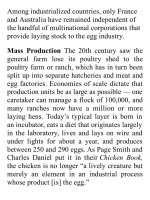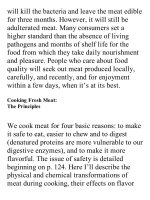On food and cooking the science and lore of the kitchen ( PDFDrive ) 410
Bạn đang xem bản rút gọn của tài liệu. Xem và tải ngay bản đầy đủ của tài liệu tại đây (122.4 KB, 2 trang )
60ºC.Somedense-fleshedfish,includingtuna
andsalmon,areespeciallysucculentat120ºF,
whenstillslightlytranslucentandjelly-like.
Creatureswithalargeproportionof
connective-tissuecollagen—notablythe
cartilagenoussharksandskates—benefit
fromhighertemperaturesandlongercooking
toturnitintogelatin,andcanbechewyunless
cookedto140ºF/60ºCorhigher.Some
molluscsarealsorichincollagenandbenefit
fromlongcooking(p.225).
WhySomeFishSeemtoDryOutFaster
ThanOthers
Onepuzzlingaspectoffishcookingisthe
fact that different fish can have
surprisingly different tolerances for
overcooking, despite similar protein and
fat contents. Rockfish, snappers, and
mahimahi, for example, seem more moist
and forgiving than tuna or swordfish,
which tend to become firm and dry very
quickly. Japanese researchers have peered
through the microscope and identified the
likely culprits: the enzymes and other
proteinsinmusclecellsthatarenotlocked
in the contracting fibrils, but float free in
the cell to perform other functions. These
proteins generally coagulate at a higher
temperature than the main contractile
protein myosin. So when myosin
coagulates and squeezes cell fluids out,
theseotherproteinsflowoutwiththefluid.
Someofthemthencoagulateinthespaces
between the muscle cells, where they glue
the cells together and prevent them from
slidingeasilyapartwhenwechew.Highly
active swimmers like tunas and billfish
require more enzymes than sedentary
bottomfishlikesnappersandcod,sotheir
fibersgetgluedmorefirmlytoeachother
if they are cooked to 130ºF/55ºC and
above.









